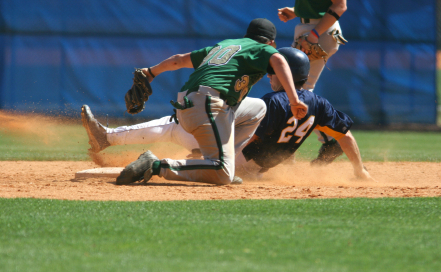The Situation:
Man on second, two outs, the five-hitter is at the plate with a 1-2 count. The runner on second has good speed. The game is tied at 2.
The Play:
The runner at second knows that the pitcher can afford to waste a pitch with a 1-2 count. As the pitch leaves the pitcher’s hand, the runner on second reads the angle as a ball-in-dirt. He breaks out of his secondary and takes off for third.
The Outcome:
The pitch bites down into the dirt, but the catcher picks it cleanly. He immediately hops up and fires a throw to third. The third baseman slaps on the tag for the third out of the inning.
What Went Wrong?
There’s an old baseball saying that you should never make the first or third out at third base. The reason is that, with nobody out, you want to give the hitter a chance to move the runner over, and with two outs, you want to give the hitter a chance to drive them in.
It’s always good to look for opportunities to be aggressive on the base paths – but you have to be smart too. We can use run expectancy to explain why the risk of getting thrown out is not worth the reward. In the Spring 2016 Baseball Research Journal, Ryan Gantner computed the threshold (percentage of the time you would have to be safe) for having the risk be worth the reward and found that with a runner on 2nd and 2 outs, a runner would have to be safe at 3rd 88% of the time for it to be worth it to attempt to take the base. For an increase of .08 expected runs (the difference from being on 3rd rather than 2nd with 2 outs), being safe has to be nearly a sure bet. The article does a great job of assigning value to a base running decision and can be read here.
In plain terms, with two outs, a runner on second has to understand that he can’t try and take third base unless he sees the ball bounce away from the catcher. You can’t break early, when you recognize the angle of the pitch out of hand, because of the possibility that the catcher will pick it cleanly, like in this scenario. It’s simply not worth the risk. By getting thrown out at third, the runner sacrificed a situation where a base hit would get his team a run, especially since the runner had good speed.
Here are some general guidelines for when to be aggressive on a ball-in-dirt. We’ll use a stoplight analogy to signal aggressiveness where green is the most aggressive, yellow is cautious, and red means advance must be a sure thing. Of course, there are exceptions to these rules, teams have their own philosophies and situational circumstances beyond outs (part of the order, strength of catcher, quality of the pitcher, etc.) are critical. This is meant to provide some general guidelines and discussion.
| No Outs | 1 Out | 2 Outs | |
| Runner on 1st | |||
| Runner on 2nd | |||
| Runner on 3rd |
On 1st Base:
As a runner on first, you will be the most aggressive. You always want to get yourself into scoring position and the throw the catcher has to make after recovering the ball is farther and more difficult to make.
On 2nd Base:
As a runner on second, you’ll want to be most aggressive with one out because advancing to 3rd can allow you to score without a hit. With nobody out, you have to give the hitter a chance to advance you or knock you in with the bat. With two outs, you need to be content with being in scoring position, and get ready to score on a base hit. As such, you should only advance when it’s a sure thing (ball to the backstop, ball kicks far away from the catcher, etc.).
On 3rd Base:
As a runner on third, you are going to be more aggressive with two outs. With 0 or 1 out, you should give the hitter a chance to drive you in and take fewer risks trying to score. With two outs, you don’t want to bank on a base hit. Depending on who is up to bat, you’ll likely want to try to steal a cheap run however you can.
Base Running Risk/Reward Recap:
There are certainly situations where you can take the extra 90 feet even when you aren’t being “aggressive” on the bases. For instance, if you’re on second with two outs, and the ball bounces 20 feet away from the catcher, taking third should be easy. No matter what color of aggressiveness you are in, always be ready.
In college, the best base runners aren’t necessarily the fastest. A lot of times, they’re the guys that can think on the base paths, anticipate things before they happen, and use situations to their advantage. Always know what situation you’re in when you’re on the bases. Think the game.






